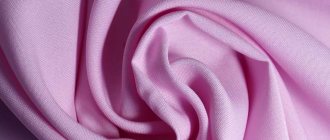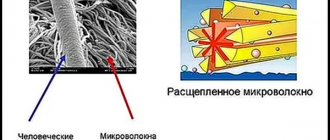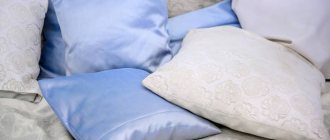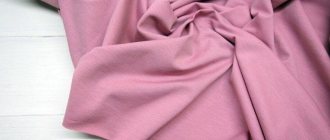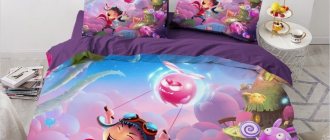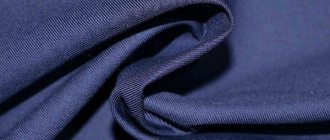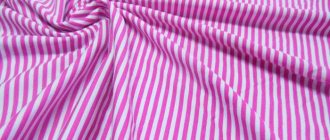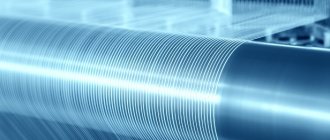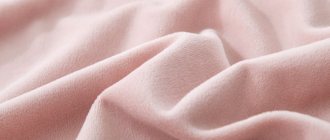Origin story
Chenille fabric is created from the yarn of the same name. The French name Chenille translates as "caterpillar", due to the thread's resemblance to a furry caterpillar.
First made in France in the 1780s by snake-braiding fiber and then cutting it into strips to make yarn. The "swirl" effect was created by treating the fabric with heat rollers. The result is a very soft, fluffy fabric. Later, the technique was refined to create imitation oriental carpets.
In the early 20th century, the United States became a center for bedspread production and hand-embroidered bedding became increasingly popular and was called "chenille."
Chenille was widely used for home furnishings rather than clothing, but clothing made from it also became popular in the 1970s.
Searched for this fabric: twill
What is better for a sofa: chenille or velor
Which material is best suited for a sofa can be determined based on the intended purpose of the furniture:
- A living room sofa requires durable and damage-resistant upholstery. It is used intensively and may be accidentally damaged (stains, puffs, scratches). Velor is better suited; if there are animals, a Teflon-coated material is suitable. If there are no animals, small children in the house and the owners are calm, respectable people, chenille will be the ideal upholstery.
- Sofa for relaxation (in the bedroom or office). The furniture is not subjected to intense exposure; chenille and velor are suitable for it.
- Sofa for a children's room. The best choice would be velor because of its environmental friendliness and ability to quickly clean.
- It is better not to choose such fabrics for a kitchen sofa. The high risk of water and fat entering will quickly render these tissues unusable.
Important! Having pets immediately rules out the choice of chenille.
The choice of upholstery fabric can also be made based on its strength characteristics and the presence of special impregnation.
For the living room, it is better to choose synthetic velor or chenille. The presence of natural fibers gives the fabric sophistication, but reduces strength. Teflon impregnation is not used for chenille. It gives special strength only to velor.
According to all the above characteristics, velor upholstery is more durable and easier to clean. Suitable for a sofa that will be used intensively. Chenille is a more delicate and presentable fabric; people leading a quiet lifestyle can choose it.
Production technology
The way it is made now is very different from how it was first made in the 18th century. Chenille is made by placing short lengths of yarn between two "warp threads" and then twisting the yarn. The wrapped yarn is cut to produce a pile effect. The edges of the pieces are then placed at right angles to the middle of the yarn, adding softness. One problem is that the knots can become loose, causing the tissue to unravel. This problem was solved by steaming lengths of yarn and using nylon.
Features of chenille thread and main types of weave
A distinctive feature of this type of fabric is the process of obtaining the characteristic fleecy structure of the finished fabric. To do this, take the main thread, into which individual fibers (mostly obtained by backcombing) begin to be woven, and then the warp is tightly twisted, acquiring a fleecy structure. The resulting yarn is then dyed and sent to weaving workshops, where the chenille thread is intertwined with the main canvas. At the same time, the more twisted strands are woven into the base, the more fleecy the fabric will be. But not only the appearance of the material, but also its weight depends on the number of threads. For example, curtain chenille has a less dense structure than furniture upholstery, so its weight will be less.
There are several main types of weave of chenille threads:
— Satin;
- Twill;
— Tapestry;
— Jacquard.
Not only the appearance and tactile sensations of the fabric, but also its density and abrasion resistance directly depend on the fiber weaving technique. Chenille fabrics with jacquard weave are considered the most expensive and valuable. They resemble tapestry in appearance and are distinguished by a particularly fine knitting of patterns.
Gorgeous, soft chenille GENEVA
Properties
Because the fibers catch light from different angles, the fabric can shimmer in different colors even if it is a solid color.
There are three main properties of chenille:
- Softness – fabric made from 100% cotton, due to its incredible softness, is used for products that are in close contact with the skin: shawls, blankets, capes, clothing.
- Beauty – One of the reasons the material is so attractive is that it can contrast with the background fabric. This contrast can create beautiful patterns. This is the perfect choice if you want to add style to your space.
- Versatility – makes it an ideal choice for any interior, from light to heavy styles. You can use chenille for everything from throw pillows and throws to upholstering chairs and sofas.
Areas of use of chenille fabrics
There are three main areas in which fabrics with chenille threads are often used:
— Manufacturing and restoration of upholstered furniture. Chenille furniture is a dense fabric of various colors, which is widely used both in the production of new armchairs, poufs, sofas and chairs, and for replacing upholstery fabric on upholstered furniture.
— Manufacturing of home textiles. If you need to decorate a window opening in an original style, just buy chenille curtains and order curtains to be sewn. Such fabric will not transmit light and is less dense compared to furniture upholstery (BAROQUE, HARVARD).
— Interior decoration. Chenille is used to make original wall panels, beautiful rugs, and bedspreads. The fabric in the interior lasts a long time, practically does not fade over time and is easily cleaned from dust and other household contaminants (NARBONNE).
Despite its practicality and high aesthetic qualities, chenille fabrics are practically not used in the manufacture of clothing. This is due to the fairly high density and weight of the material. Sometimes bathrobes with various thematic patterns are made from chenille.
Soft jacquard chenille RENAISSANCE
Advantages and disadvantages
Tightly woven chenille is durable and can be used in walk-through areas. The material is best suited for bedrooms, offices, children's rooms or living areas with low traffic.
Chenille that is not tightly woven is easily damaged; such material should be stored away from water and moisture. The surface is difficult to clean as you cannot use water or regular cleaning products on them. You can vacuum the top layer and brush with a soft bristle brush. Follow the cleaning instructions on the label or on the manufacturer's website.
The color of the surface may change in direct sunlight.
Some types of fabric can be dry cleaned. If the label says you can wash it in a washing machine, you can machine dry it on low heat. It is not recommended to hang dry.
Advantages
- soft to the touch
- drapes easily
- has a slight shine
- thick and durable
- absorbs water
- abrasion resistant
- keeps warm
- versatility
Recently viewed with this fabric: tapestry
Flaws
- difficult to care for
- may stretch and become deformed
- shrinkage possible
Characteristics and description
Interior chenille fabric is strong, durable, with a velvety front side and a smooth backside. The name of the material comes from the word chenille, translated into Russian as “caterpillar”, due to the special structure of the fibers: the fluffy thread is twisted in a spiral.
Chenille fabrics are made using various weavings: satin, twill, jacquard and tapestry. The higher the density of the fabric, the greater its weight.
Types of chenille are divided into several groups according to their composition:
| Group | Fiber | Basic properties | Examples |
| Natural | Cotton (more than 60%) | Hypoallergenic, soft, safe | Kuwait |
| Artificial | Viscose | Tactilely reminiscent of natural canvases | Shakira, Victor, Durango |
| Synthetic | Polyester and polyacrylic | Resistant to stains, some types have an anti-vandal effect | Sherwood (vandal-proof material) |
| Mixed | Natural and synthetic | Practicality, high wear resistance | Coxo, Forte |
The structure of the fabric depends on the weave. The main properties of chenille include:
- no shrinkage;
- the fabric does not stretch or wrinkle, it is moderately elastic;
- drapes well with large folds;
- color stability: does not fade or fade;
- beautiful in appearance and pleasant to the touch;
- does not form pellets;
- hypoallergenic.
Wear resistance
The wear resistance of chenille fabrics depends on the raw materials used in production. Natural materials made from cotton, matting and linen are environmentally friendly and hypoallergenic. They are recommended as upholstery for furniture in a children's room.
But these materials, in comparison with mixed and synthetic ones, have low wear resistance. An alternative option is chenille, in which the base layer is made of natural fibers, and the upper part is made of polyester or acrylic threads.
The highest wear resistance is found in materials of synthetic origin. It is worth considering that most samples have a common disadvantage: they are vulnerable to the claws of pets. For example, fabrics with jacquard or tapestry weave are not considered vandal-proof. Threads of the material are easily pulled out and damaged by mechanical stress. Pet owners should choose fabrics with Teflon coating and special impregnation.
Unlike velor, the fabric is considered more wear-resistant. It is quite difficult to damage it.
Compound
The composition of chenille fabrics is varied. Characteristics of the fiber used:
- Chenille made from natural cotton raw materials is safe and environmentally friendly. Does not cause allergic reactions. Demonstrates low wear resistance.
- Viscose gives the canvas a noble glossy shine. Artificial fabrics and mixed varieties are more durable. They are distinguished by softness and high density.
- Synthetic types of chenille made from acrylic and polyester have the ability to repel moisture and dirt. In the group of interior materials, they are the densest and quite rigid. Thanks to treatment with special compounds, they are the most durable and wear-resistant.
Care and cleaning
Furniture chenille usually consists of cotton, rayon, wool, silk or a combination of these. Due to differences in fiber composition, different types of chenille require different cleaning methods. Although durable, this fabric has a tendency to shrink; for home care, stick to regular vacuuming and spot cleaning with cleaning products. Instead of washing the covers by hand, it is better not to remove them, but to clean them directly on the furniture. Have your furniture professionally cleaned every few years.
It is better to remove stains from upholstery using mild liquid soap that does not contain dyes, or washing powder for delicate fabrics. Do not rub the pile too much, do not wet the rag too much.
Chenille upholstery fabric: care features
You can see that each upholstery material for sofas has its own advantages and disadvantages. Therefore, you need to choose taking into account your own requirements and capabilities, as well as the pros and cons of chenille upholstery.
Each textile material needs special care, the features of which you can find out in the special “Care” section on our website.
Our portal presents high-quality photos of chenille furniture fabrics.
For more information about the material, see:
Video: comparison of furniture chenille, jacquard and tapestry
In the video, a furniture store worker compares fabrics one by one: chenille, tapestry, jacquard, flock, velor, matting, suede and faux leather.
See similar articles
- Blackout - light-proof dense fabric for curtains
- Tweed - fabric made from natural wool for suits
- Corduroy is a durable textured fabric with a soft texture.
- Oil - dense, delicate fabric for women's clothing and dresses
- Batiste is a thin translucent fabric for summer clothing.
- Percale - durable fabric for luxury bedding
If you liked the article, share it with your friends!
Let's summarize - pros and cons
Advantages of upholstery chenille:
- easy to cut and drape;
- the fabric does not wrinkle, does not peel, does not absorb odors;
- natural fabrics are hypoallergenic and environmentally friendly;
- synthetic and artificial materials demonstrate high strength and wear resistance;
- pleasant to the touch texture, noble appearance, variety of shades;
- more affordable than other less practical types, for example, velor;
- easy to care for, does not fade or shed;
- Thanks to special impregnations, it is resistant to contamination. Fabric with Teflon treatment demonstrates anti-vandal properties.
The disadvantages include:
- natural chenille easily absorbs liquid, is less resistant to stains, and is short-lived;
- the material is not resistant to mechanical damage—cat claws easily form snags on the surface. Tapestry and jacquard weaving fabrics are especially vulnerable;
- requires delicate care. Contamination should be removed immediately. For all types of chenille, dry cleaning without the use of aggressive agents is recommended. Exceptions are furniture covers made from a material with a lower density.
How to choose the right fabric structure
In this article we talked about all the popular types of material for upholstery of upholstered furniture. There are nine categories in total. The numbering starts from 0 and continues to 8. The characteristics of the groups may differ between manufacturers. But the higher the class number, the better and stronger the “second skin” of the sofa.
Expert opinion
Stepanov Mikhail Filippovich
Designer of private and commercial interiors. 5 years of experience.
The first group included the thinnest options with relative strength. In the second - the same products as in the previous one, in composition, but with a higher level of wear resistance.
The third includes almost all main types of materials with complex finishes. The fourth class contains expensive tapestries, suede and chenille.
Fifth - types with natural fibers. The sixth is leatherette.
The seventh group is some varieties of flock. The eighth category implies exclusively expensive and natural leather.
When choosing an option for finishing furniture, it is necessary to take into account the purpose of the piece of furniture and the microclimate in the room. For a children's room, you should give preference to natural elements.
For the living room you need to select fabrics that are resistant to wear and tear. All you have to do is make the right choice of material and find out what is best for your sofa.
Which sofa upholstery is better if you have a pet?
The presence of animals in the house increases the likelihood of furniture damage many times over, unfortunately. And you should not believe the admonitions of sellers about the new “anti-pet” or “anti-claw” technology.
Nothing can guarantee 100% protection of the fittings. Which fabric is better for upholstering a sofa in this case? Very, very dense, with a fine weave, such as flock or velor. This will make it difficult for your pet to pick up the thread, and sharpening its claws will be inconvenient.
And he'll probably lose interest quickly.
You can also purchase protective covers, although this is a temporary measure. There is no point in using them on an ongoing basis.
If there is a puppy in the house or you are planning to have one, choose furniture without fittings, with metal legs. Dogs are partial to wood, especially during puppyhood when they are teething.
Otherwise, advice from veterinarians on raising a pet will help protect the accessories.

